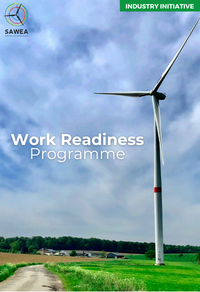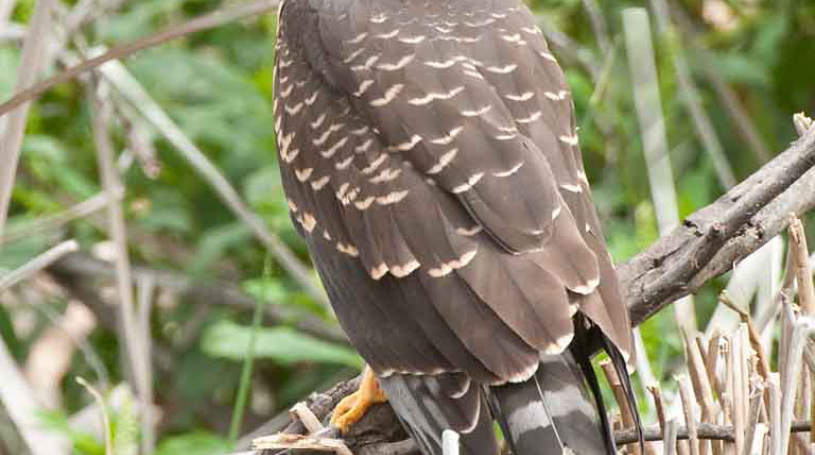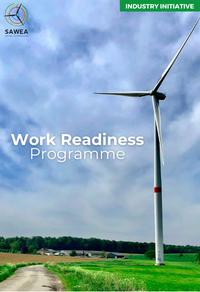Black Harrier in More Danger Than Black Rhino
Eastern Cape, May 2023 With only 1300 Black Harriers left in the world, this raptor is Southern Africa’s scarcest endemic bird of prey, moving from Vulnerable to the Endangered list almost a decade ago. “This beautiful bird of prey is only found in Southern Africa and is in more danger of extinction than the Black Rhino, which has over 6 000 remaining individuals, compared to the Black Harrier’s population that comprises fewer than 1000 mature breeding birds demonstrating the urgent need for conservation efforts,” explained Marli Schoeman, ESG and Biodiversity Manager at Jeffreys Bay Wind Farm.
Conservation efforts, led by Jeffreys Bay Wind Farm and its conservation partners in the Kouga region, are working to increase awareness and reverse the current trajectory that shows that this this beautiful bird is likely to go extinct within 75 years if nothing is done. Raptors play an important biological role in the control of rodent agricultural pests and other small mammals, an important consideration over and above the services that these birds provide to our greater natural environment.
The Black Harrier nests on the ground, and it only breeds in indigenous natural vegetation, preferring fynbos and renosterveld. Vast areas of natural fynbos have been cultivated for crops and the Harrier’s breeding habitat has shrunk to tiny remnants. Other impacts are human disturbance, poisoning by agrochemicals and pesticides, and poorly placed electricity powerlines or wind turbines. “The coastal fynbos plains around Jeffreys Bay are ideal Black Harrier habitat, here we find important breeding, roosting, and foraging areas essential to the survival of their population. Most of this habitat is located on privately-owned land, and private landowners can therefore play an important role in conserving the local Black Harrier population,” added Schoeman. To increase awareness, the Black Harrier Conservation campaign is sharing information with landowners:
- Report sightings.
Keep an eye out for Black Harriers as you drive around and report any sightings to the following number +27 63 507 5829. We need to know date, time of sighting, location (GPS co-ordinates, if possible) and what the bird was doing. The data will help conservation scientists to better understand the movement patterns of Black Harriers within the landscape.
- Minimise disturbance to nesting birds.
Black Harriers build cryptic nests on the ground, and they therefore need adequate vegetation cover during their breeding season to hide their nests and ensure successful breeding. In the Jeffreys Bay area, the breeding season for Black Harriers is usually from August to December. If you suspect that there are Black Harriers breeding on your property, please try to limit disturbances (e.g., human activities, livestock grazing, etc.) in the area as far as possible. Since Black Harriers are ground-nesting birds, they are very easily disturbed and will often abandon their nests when disturbed.
- Protect overnight roosts.
Black Harriers can spend nights together in groups on the ground. They usually gather at roosting sites around sunset and leave again before sunrise. Since they tend to return to the same roosting areas every year and spend long hours at the roosts, conservation of those areas are extremely important for their survival. If Black Harriers are found roosting on your property, please try to minimise any disturbances at the roosting sites (e.g., human activities, livestock grazing). It is also important to ensure that roosting areas are not grazed too short or intensely by livestock, since Black Harriers needs sufficient vegetation cover to ensure that they are not exposed to predators.
- Protect the natural fynbos vegetation on your property.
Clearing or mowing the natural vegetation will destroy the habitat for Black Harriers to breed, roost and forage.
- Don’t burn between August and December.
Plan controlled burning of the fynbos to avoid the Black Harrier breeding season from August to December. Where controlled burns are used as a veld management tool, aim to achieve a patchy mosaic of burnt and un-burnt areas (rather than to aim for a complete and clean burn).
- Consider formal protection.
You can even conserve safe refuge areas on your land for Black Harriers to breed, roost, and forage. There are many ways to do this, one of which is to secure legal conservation status for your land (or parts of your land) with important habitats for Black Harriers. Please contact the Greater Kromme Stewardship initiative for more information (072 534 5914 or wentzel@conservation-outcomes.org).
- Report illegal bush clearing.
If you detect illegal clearing of indigenous fynbos vegetation, please report the matter to the Green Scorpions at 0800 205 005.
This programme forms part of the wind farm’s overarching biodiversity efforts, focused on achieving net gains to critical biodiversity impacted by its operations. Having set up a Biodiversity Advisory Committee three years ago, which includes bird specialists, environmentalists and wind farm employees, Jeffreys Bay Wind Farm continues to push its biodiversity agenda. 2022 saw the wind farm commence with its second bird conservation trial following a successful pilot study. Known as an Observer Led Shut Down on Demand (OLSDOD) programme, it is aimed at mitigating the loss of priority bird species on the wind farm. In addition to Black Harriers, there are two other endangered bird species (Martial Eagle and African Marsh-Harrier) on the priority list, as well as five other lesser-threatened species, namely: Lanner Falcon; Secretary Bird; Blue Crane; White Bellied Korhaan; Lanner Falcon; and the Denham’s Bustard.










